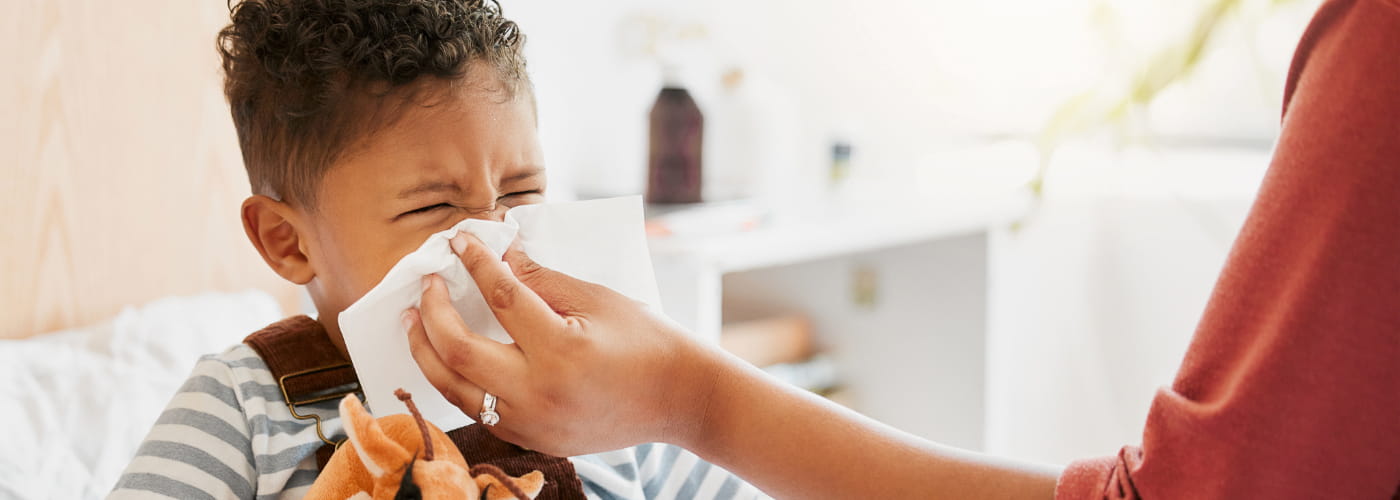Does my child have a cold or allergies? And why does it matter?

When your child has a runny nose, cough or congestion, it can be hard to tell if it's from a cold or allergies. While some symptoms overlap, others are more closely associated with either a cold or allergies, which can help you distinguish between the two.
"It can be helpful to know the cause of your child's symptoms, not only because different treatments are recommended for colds and allergies, but because colds are highly contagious," says Annamarie Koller, DO, pediatric hospitalist, Children's Hospital of Philadelphia (CHOP) at Bryn Mawr Hospital, part of the Main Line Health and CHOP affiliation.
Dr. Koller explains that most colds are viral infections and easily spread through direct personal contact, exposure to airborne respiratory droplets (breathing the same air after someone sick has sneezed or coughed) or contact with the pathogen (or bug) on surfaces.
"Although there's not much you can do to avoid your child bringing a cold home from school, there are steps you can take to reduce the rest of your family's exposure," says Dr. Koller.
These include reminding your child to cover their sneezes and coughs, encouraging good handwashing and disinfecting surfaces - especially areas that are used frequently by the whole family, such as doorknobs, refrigerator handles and TV remotes.
Allergies, explained
In simple terms, allergies occur when the immune system overreacts to a trigger. Respiratory allergies &mdash which can show up as allergic rhinitis (hay fever), allergic asthma and sinusitis - cause the body to release histamine and other chemicals into the bloodstream. Histamine can cause a variety of symptoms, from itchy eyes to sneezing to difficulty breathing.
Allergies can be seasonal (pollen, grass or trees) or year-round (dust mites, mold or pet dander). They are common in people of all ages, even young children, though rarely in those under one year old.
Symptoms of colds versus allergies
"One way to tell if your child has a cold or allergies is if they have a fever or body aches. Allergies don't usually cause these symptoms, but colds can, especially in the beginning," Dr. Koller says.
Colds and allergies often share these upper respiratory symptoms:
- Stuffy or runny nose
- Sneezing
- Coughing
- Wheezing
Allergies are often associated with an itchy nose, throat or ears and itchy, red, watery, or swollen eyes. They can also cause dark circles under the eyes, sometimes referred to as "allergic shiners."
Additional ways to identify if
your child has a cold or allergies include:
- Energy level - Though allergies can sometimes cause mild tiredness in kids, most often they are still able to play and go to school despite their symptoms. If your child's symptoms include exhaustion, it's a good indication they're dealing with a cold.
- Nasal discharge - Colds typically start with clear, watery nasal discharge that gets thicker and may turn whitish, yellow or green. Nasal secretions caused by allergies always remain clear and thin.
- Duration of symptoms - A typical cold usually lasts 3-7 days (or up to two weeks), while allergies may stick around for weeks or months.
Treating colds and allergies
"The goal of treating a cold is to make your child more comfortable," Dr. Koller says. "With allergies, you'll want to treat the symptoms and, if possible, minimize exposure to the source of the allergy."
Cold symptom treatments include:
- For young children: a bulb syringe to suck out excess nasal mucus and a humidifier or steamy shower to help control symptoms
- Children's acetaminophen or ibuprofen for aches and fever (consult your provider first)
- Saline solution or spray to relieve nasal congestion (consult your provider first, as safety guidelines vary by age and product type)
- Honey, which can help soothe a sore throat or help with a cough. It is considered safe only in children over one year old
"Always avoid giving children under six years old cough or cold medicines," says Dr. Koller.
Allergy symptom treatments include:
- For children over two years old: a non-drowsy oral antihistamine, such as cetirizine (brand name Zyrtec) or loratadine (brand name Claritin), for runny nose, sneezing and itching
- For children over four years old: corticosteroid nasal spray, such as Children's Flonase, for runny nose, congestion, sneezing and itching
To help reduce your child's reaction to allergens, have the child bathe after being outside, wash clothing using hypoallergenic detergent, dust and vacuum often and use indoor air purifiers. You can also talk to your child's pediatrician about the best way to reduce their exposures, since every child's allergies are different.
When to see a doctor
Contact your child's primary care provider if your child is three months old or younger and experiencing nasal or chest congestion, or if your child is at least four months old with these symptoms:
- A wheezing cough or coughing up thick, greenish mucus
- A barking cough
- Thick nasal discharge for more than 10 days
- Fever that reaches 104 degrees Fahrenheit or a temperature higher than 100.4 lasting more than three days (or more than one day in a child under two)
- Ear pain (colds can lead to ear infections, which need antibiotics)
- Severe headache
If your child has recurrent respiratory allergies, talk to your pediatrician. They may refer you to a pediatric allergist or pulmonologist for allergy testing and treatment.
Always seek emergency care or call 911 if your child is having difficulty breathing or their lips or fingernails look blue.
Next steps:
Meet Annamarie Koller, DO
Learn more about the Main Line Health and CHOP affiliation
Learn more about respiratory illnesses and keeping your child healthy
 Content you want, delivered to your inbox
Content you want, delivered to your inbox
Want to get the latest health and wellness articles delivered right to your inbox?
Subscribe to the Well Ahead Newsletter.
